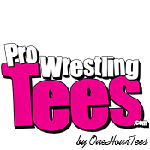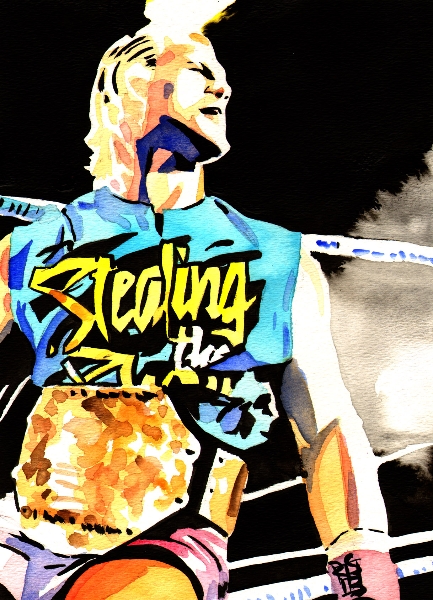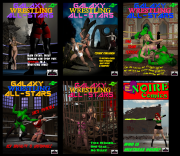Chapter 19: Wrestling on TV by Matt Murphy
Posted by flairwhoooooo on January 11, 2010
By Matt Murphy
Working with cameras rolling requires some instruction. We did a two-camera shoot — we had one hard (stationery) camera and one floor camera — so I will base everything I say on our two-camera shoot.
Rule number one: don’t screw with the equipment. Never touch a camera or slam a microphone. The equipment we used in our two-camera shoot cost more than $10,000, and that’s a fortune to an independent promotion.
During your entrance, you should make yourself visible to the man holding the floor camera, since he is probably the one filming your entrance. Let him get a good shot of your face for the benefit of the viewers. During tag team matches, both members of a team should be walking side-by-side and close enough together that the floor camera can get both wrestlers in the same shot. Neither wrestler should lag too far behind the other. If you have a championship belt, make it clearly visible.
Don’t walk between the ring announcer and the hard camera while he is making an introduction and don’t take five minutes to complete your entrance. With a few exceptions, an entrance should last no longer than one minute from your introduction to the end of your entrance (thirty seconds is even better).
Work towards the hard camera when possible. While the floor camera will get some shots and miss others, the hard camera is usually a safe shot that doesn’t miss the action. Since the majority of fans at small shows will be on the opposite side of the hard camera, it might feel awkward at first working away from the fans. Try to balance the direction of your work between the hard camera and the fans.
The cameras pick up everything, so it is important not to whiff on shots or let yourself be seen communicating with your opponent. When you are in a hold and somebody is calling something to you, move your hands as if to try to push against the pressure or find a reversal to draw the viewer’s eyes from the moving lips to the moving hands.
You must remember that when viewers watch you week after week, they start to pick up on things. Don’t become predictable. As a fan, I always wondered why in the hell anybody would ever try to power-bomb Billy Kidman, because I knew that every time they tried he would counter into a sit-out face-buster. If wrestling was a shoot, his opponents would have him scouted and would know not to try to power-bomb him.
Television is a higher-pressured environment compared to house shows. Many wrestlers stress out for fear of not hitting the time mark given for their match. Unless it is live TV, a match can be clipped if it goes too long. I personally hated my match being clipped: it felt like tearing pages out of a book and still expecting people to understand and enjoy the story. However, going too long is far better than going too short. As a producer, it was a nightmare to deal with the program running short on time, because I had nothing to fill the time. I’d need an extra match if I was short, which meant two wrestlers would have to have an impromptu match with no time to discuss anything in advance, or I’d have to create a video package to fill the shortage. Be sure to communicate with the referee and make sure you know where you’re at on the timekeeper’s clock throughout the match. The ref will quietly ask the timekeeper or ring announcer for the elapsed time and then relay the info to you.
While TV adds pressure, it is also gives wrestlers an added outlet for their creativity. A decent announcer can identify the story being told inside the ring and get it over with the viewers, meaning you can go many different directions in your matches.
You’ll likely be asked to cut promos for television. This should serve as at least one of three purposes: to plug an event, to get your character over, or to hype or advance a storyline.
During the 2007 Harley Race/Pro-Wrestling NOAH camp in Eldon, Missouri, I led the wrestlers through the delivery of promos. I gave each wrestler a scenario and he would cut a promo based on it. One scenario was something like, “You’re debuting on Smackdown tonight against Matt Hardy. I need a one-minute promo to air before your match. We need to know who you are, what you’re about, and why people should watch your match.”
Unfortunately, promos aren’t taught in many wrestling schools and have to be learned by doing. In this promo, the wrestler is debuting, which means we need to know who he is and what he’s about. Next, we know that he’s wrestling Matt Hardy. He needs to put Hardy over as a talented wrestler in some way, shape, or form: calling Hardy a “nobody” does nothing to benefit either wrestler. Get your opponent over, but then tell the fans that you’re going to bring the fight to him in your character’s own unique way.
While cutting a promo, a wrestler should not sound like he’s chatting with his brother on the phone. He can be cold and calm in an ominous way, excited, or angry. He should also not look like he’s auditioning for Zeus’s stunt-double in “No Holds Barred.” Movement should be subtle and front-to-back, not side-to-side, to ensure that the camera shot doesn’t lose the wrestler.
You may also be asked to sit with the play-by-play announcer and provide color commentary. The whole point in doing commentary is not to get yourself over, but to talk about the match in the ring — the strategy, the story, your experiences wrestling those in the ring — and the angle, if any, that you’re a part of. It’s good to use commentary to get over a feud you’re in, but don’t let that dominate the conversation. Let the play-by-play announcer feed you and lead the conversation in the direction he needs it to go. Don’t do play-by-play while providing commentary — that is the play-by-play announcer’s job — and don’t talk over him. It sounds awful when you hear people talking at the same time on TV. Finally, don’t bury other wrestlers during commentary. I once had a wrestler bury the entire roster other than himself while providing color commentary, and when he finished I asked him why any viewer would buy a ticket to see a group of wrestlers who suck. “I was just being a heel,” he said, but it doesn’t get heat and it’s bad business to put yourself over at the expense of the company.
If you’re interested in doing play-by-play, here is the best advice I can give you: don’t abuse your viewers’ trust by lying to them or insulting them with extreme exaggerations. Don’t say that a wrestler is 40 feet in the air when he is only six feet from the mat. Don’t say that one guy was kicked in the mouth by a dropkick when he obviously took the impact in the chest. Don’t use “He may have broken him in half!” too much: after hearing it a dozen times, the viewer becomes numb to hearing about a wrestler being halved without actually seeing it occur. Use your voice (don’t try to sound like Michael Buffer, because it’s hard to understand), project it clearly, punch keywords, keep a steady pace except during the most dramatic moments, and be enthusiastic but don’t yell at your audience.
Airing a television program on the indie scene usually requires taping more than one week of television programming at a single event. The first time I did television, I was instructed to always bring two sets of gear, so if I had to work twice it would give the impression that the viewers were seeing me in two different weeks. I hated that, as some of those viewers may have been at the event and could remember otherwise. In announcing, I hated to refer to the two tapings as separate weeks and eventually lobbied, successfully, against it.
Remember, the television cameras pick up everything that the fans see and hear (and in larger arenas, much of what fans can’t see or hear). A whiffed punch can be hard to edit out, as can a wrestler calling a spot too loudly. Despite the extra labor required to be a part of a television program, it’s the best kind of exposure and gives wrestlers a chance to learn to be a part of angles that fans can follow, so it’s definitely worth the trouble.
Somebody Get Out There!
The first-ever World League Wrestling on PAX-TV programs were taped in February 2002 in suburban St. Louis. Harley originally had me penciled in to lose to our champion, “Drill Instructor” Dennis McHawes, in the first taping, which I would have been fine with except the second taping featured me in a six-man tag match against McHawes, Trevor Murdoch, and former NHL star Tony Twist, a legendary ass-kicker.
The story was that I’d do interviews for radio and TV stations and I’d knock Twist, hurling insults like, Hockey players are nothing more than fighting figure skaters. “When I step into the ring with him, I’ll drop him with a right to his jaw,” I promised. Because Twist and I built interest and had people talking about the match, I didn’t want the TV viewers or the live audience to see me until that match.
Since he was our champion, McHawes needed a strong win on our first taping and I didn’t want to cheapen the pop Twist would get when he hit me with his haymaker. I instead recommended that Derek McQuinn, a student of mine who I thought was believable enough to look like a threat to the champion and who wouldn’t be hurt by losing, since we could get him over by saying that he was the first rookie in WLW history to receive a shot at the title.
I was stretching in the locker room during the first taping when referee Skippy Johnson burst through the door, frantic. He told me that the main-event match for the first taping went short and that he needed a short match from “anybody.” I thought quickly and decided that it wouldn’t hurt to get a strong win first, so I told Skippy to send somebody to the ring to put me over as I was running down the hallway.
I entered the ring and waited for my opponent, who turned out to be another one of my students, Josh Besore. I called the opening spot to the referee as he was checking me for foreign objects, then he relayed the spot to Besore. I called everything on the fly, we had a so-so match, and I went over to look like a legitimate threat to Twist. I really wanted to win by knockout to establish that I had a heavy right hand, since I’d promised to drop Twist, but that’s just not something you do on a Harley Race show without his consent.
Off-topic but important to note, I did drop Twist to the mat with a punch in the six-man match because I thought it was important, as a heel, to make good on my promise and not just talk trash. Of course, it didn’t knock him out and he eventually knocked me out with a two-punch combo. He didn’t pin me, though: no way in hell would I let a hockey player pin me inside a wrestling ring. Trevor dropped an elbow on me, which I could later put over as the blow that put me away, and covered me for the pin.
NEXT WEEK:
Chapter 20: When Things Go Awry
Chapter 21: The Elephant in the Room
Chapter 22: Being Booked for a WWE Show









Leave a comment